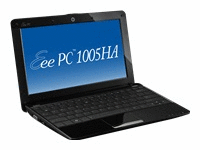
As a master of the build-to-order PC, it's no surprise that Dell has managed to create a reasonably customizable version of the Netbook. While most vendors offer them as one-size-fits-all solutions (or with only very minor options, such as color and hard drive), the Inspiron Mini 10 has plenty of ways it can become the perfect Netbook for you. Our $593 review unit has some features that are far from the Netbook standard, including a higher-resolution 1,366x768 screen, an HDMI output, a TV tuner, a funky lid design, and an edge-to-edge glass overlay on the display. Shell out even more, and you can get built-in mobile broadband or GPS. Of course, at nearly $600, this is getting dangerously close to mainstream laptop territory, and we could think of several better ways to invest that kind of money in a laptop. And, if you're just a fan of the wide flat keys and reasonably slim design of the Mini 10, you can get virtually the same experience from the budget-friendly Mini 10v, which starts at just $299.
Not as streamlined as Asus' latest Netbooks or the minimalist HP Mini 5101, the Dell Mini 10 instead takes its design cues from the bigger laptops in the Inspiron family, with similar rounded edges and shiny surfaces. It's a smart move for bringing in first-time Netbook buyers, as the familiar look and feel make taking the Netbook plunge less daunting. There's thankfully little wasted space in the keyboard tray, with wide, flat keys going nearly edge-to-edge. Unlike Dell's earliest 9-inch Netbooks, there are no missing keys or major space compromises, and important keys, such as the Shift, Tab, and Ctrl keys, are relatively full-size.
The narrow wrist rest keeps the system from extending out too far and becoming unwieldy, but that requires a long, letterbox-style touch pad, with the mouse buttons integrated directly into the lower left and right corners of the pad. It's far from our favorite Netbook touch pad, but better than the similar long touch pad with buttons on the far sides found on HP's Mini 110. The 10.1-inch wide-screen display is the systems' most noteworthy feature, with a 1,366x768 native resolution. A standard 1,024x600 is also available on other configs of the Mini 10. We were worried that the higher resolution would make text too small to read, but we quickly got used to it. A handful of other Netbooks, including Sony's Vaio W, also offer these higher-res screens, and we would love to see it become the new Netbook standard. The edge-to-edge glass over the display looks nice, but also adds to the glare--something to be aware of if you're sensitive to that.
The HDMI port on the Mini 10 is a nice touch, and may be the first time we've seen that on a Netbook. An optional TV tuner is an interesting idea, but TV tuners in general have never connected with mainstream consumers, and have largely been eclipsed by Hulu, Netflix, Slingbox, and other online TV-viewing tools.
Both AT&T and Verizon mobile broadband modems are available for $125. Unlike most of the Netbooks we've reviewed, the Dell Mini 10 uses the Z530 version of Intel's Atom CPU, instead of the typical N270 version. While both have a 1.6GHz clock speed, the Z-series runs cooler and was intended for handheld mobile Internet devices (sometimes called MIDs). In our benchmark testing it ran slower than the Dell Mini 10v that has the N270 version of the Intel Atom, which was specifically designed for Netbooks. The difference wasn't severe, however, and the Dell Mini 10 works well for basic Netbook tasks, including Web surfing, basic media viewing, and working on office docs, which is what Netbooks are primarily intended for.
No comments:
Post a Comment